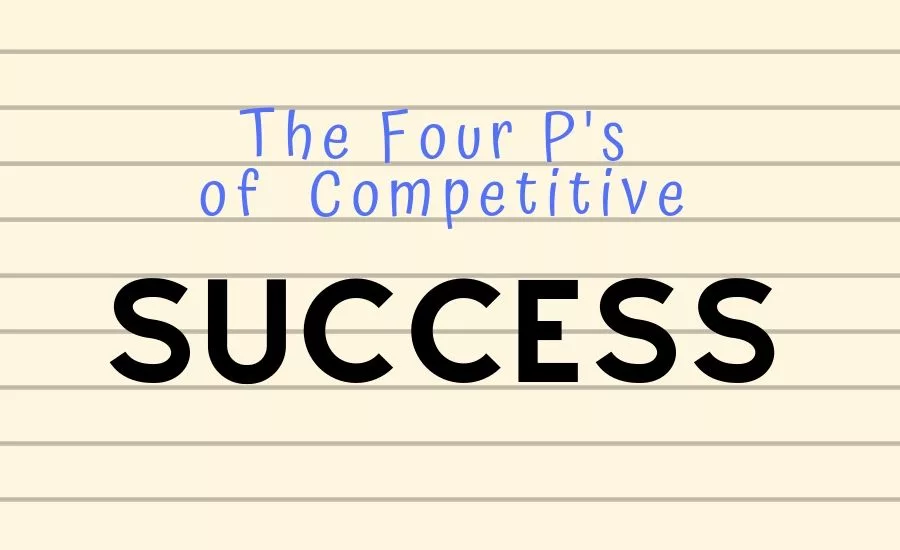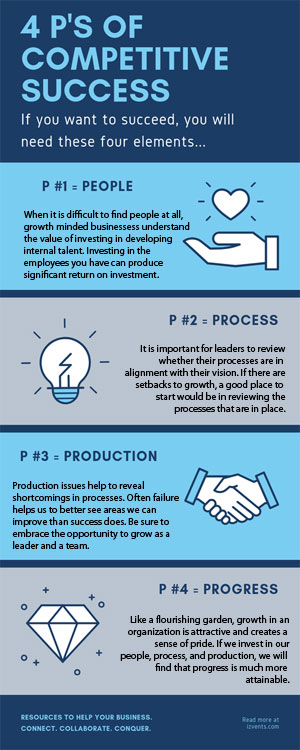The Four P's of Competitive Success

We all say we want to succeed. There aren’t many entrepreneurs or leaders who go to work intending to fail. Yet, failure seems to find us while success eludes us. Jim Rohn encourages, "Successful people do what unsuccessful people are not willing to do. Don't wish it were easier; wish you were better." Anyone who tells you they have found the silver bullet of success has been drinking too many Silver Bullets. To help you narrow your efforts, we have found that in order to be competitive you will need people, processes, production and progress. If you can master The Four P’s of Success, you will be in a position to achieve your growth potential.
Key to Success: People
People. In a tight labor market, recruiting, developing and retaining good people is at the top of the list for a competitive advantage. The right people can make or break an organization. Yet, success with people is not as straight forward as simply finding and keeping the right people.

As Jim Collins noted in Good To Great, you need to get the right people on the bus [your organization] and you need to ensure they are in the right seats on the bus. When it is difficult to find people at all, growth minded businesses understand the value of investing in developing internal talent. Investing in the employees you have can produce significant return on investment.
Whether you are an entrepreneur or a person in a position of leadership at the helm of a large organization, attracting good talent starts with:
- Have an identity. Why would someone want to work for your company? Create clarity on your vision and values.
- Develop a process. What does it look like to be successful in your organization? Develop a system for determining talent.
- Be open minded. When was the last time you went outside of the box? Be willing to take chances on people with the good qualities who may not fit the mold.
- Patience is a virtue. Before you rush to discipline or termination, assess how well you and the organization have helped this team member succeed. Perhaps it’s time to fix the system.
Key to Success: Process
Process. Culture and systems have to be in sync with each other for a company to succeed. While culture is a hot topic, it is more about what an organization does than what it says it will do. It is important for entrepreneurs and leadership teams to review whether their processes are in alignment with their vision. If there are setbacks to growth, a good place to start would be in reviewing the processes that are in place. Developing systems helps to ensure that there is consistency in your organization. Clarifying expectations helps team members to understand what they need to do in order to succeed. Communicating processes that are consistent with the vision enable everyone to see where they can help move things forward.
Key to Success: Production
Production. A company has to produce goods and/or services. Having the right people and processes completes the cycle of needs to ensure an organization will create value through production. Production issues help to reveal shortcomings in processes. Often failure helps us to better see areas we can improve than success does. Be sure to embrace the opportunity to grow as a leader and a team. Production, process and people all work together to create progress. If you are struggling to make progress start to work backwards to determine areas that need to be addressed.
Here is a good resource from EOS on how to trace down issues and establish better meetings.
Key to Success: Progress
Progress. Having the right people, developing your processes and improving production are all keys to success. There is no guarantee for success. There are no short cuts to success. Leaders can learn a lot from gardening on how to cultivate a growing team. In an article published with Restoration and Remediation Magazine, we identified keys to change for withering grass, flowering weeds and crab grass within an organization. Like a flourishing garden, growth in an organization is attractive and creates a sense of pride. If we invest in our people, process and production we will find that progress is much more attainable. As the organization moves forward together it is easier to identify and address areas of the company that need to be adjusted. Progress is not perfection. Progress means we are gaining on our goals.
Looking for a reprint of this article?
From high-res PDFs to custom plaques, order your copy today!








